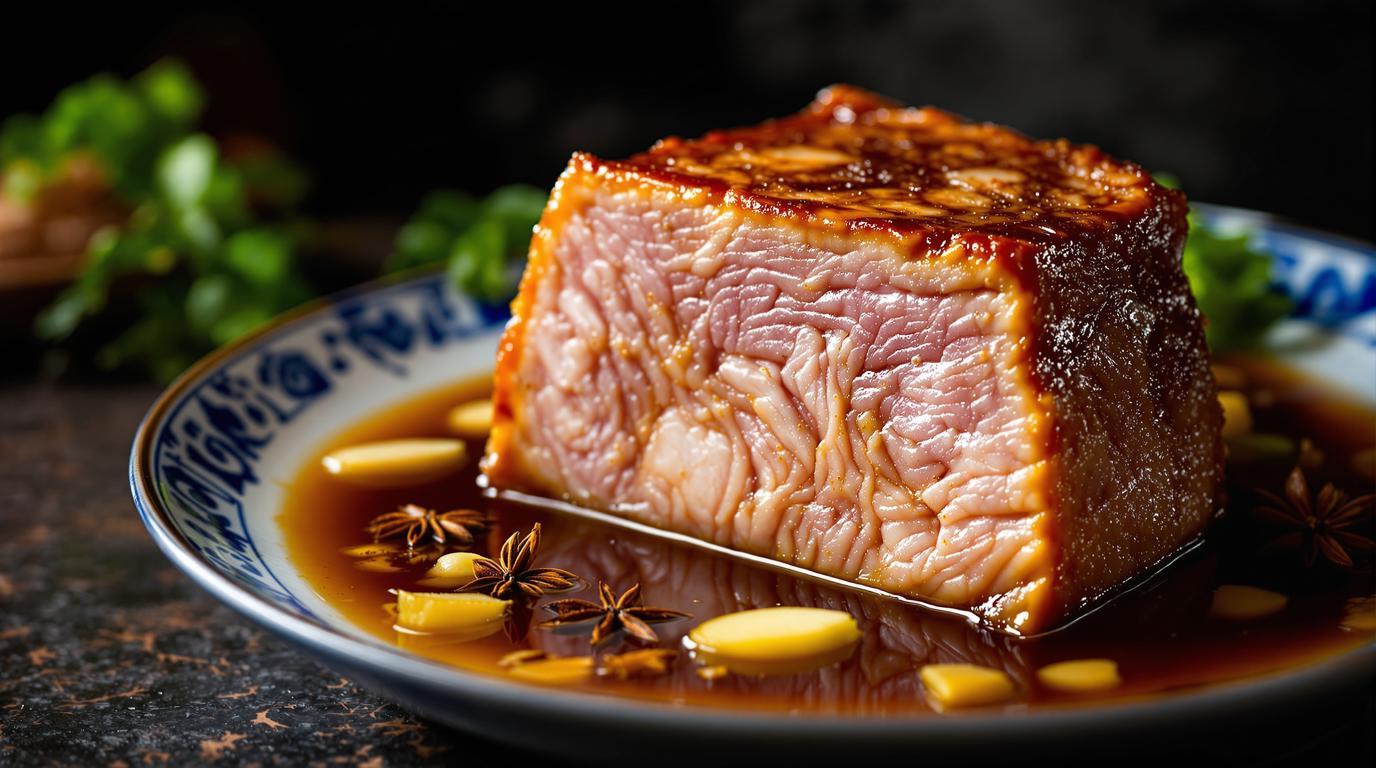There’s something almost magical about a piece of pork belly transforming through time and patience into one of China’s most cherished culinary treasures. My first encounter with Dongpo Pork was in a small, steamy kitchen in Hangzhou, where my mentor showed me how this humble cut could become something extraordinary. The story of this dish dates back to the 11th century, created by Su Dongpo, a revered poet and statesman who inadvertently created culinary history during a time of food scarcity. What makes this dish truly special isn’t elaborate ingredients but rather the slow dance between pork, aromatic wine, and time.
The Story Behind Dongpo Pork 📖
Legend has it that Su Dongpo was so absorbed in writing poetry that he forgot about the pork belly slowly simmering over his stove. Hours later, he returned to find the meat had been transformed – tender enough to melt on the tongue yet still holding its shape. This “mistake” became one of China’s most celebrated dishes, representing the beautiful balance between rustic home cooking and refined technique.
In my two decades cooking professionally, I’ve prepared this dish hundreds of times, and each time I’m reminded that truly great cooking often comes from simplicity and patience – not unlike the traditional Spanish Sunday feasts that transform humble ingredients through slow cooking.
Essential Ingredients 🧾
The soul of Dongpo Pork lies in just a few key components:
- 600g pork belly with skin intact (about 1.3 lbs)
- 200ml Shaoxing wine (1 cup)
- 60ml light soy sauce (¼ cup)
- 15ml dark soy sauce (1 tablespoon)
- 80g Chinese rock sugar (⅓ cup)
- 8 slices fresh ginger
- 3 whole scallions
- 1 star anise
The Shaoxing wine is absolutely non-negotiable – it provides the distinctive flavor foundation that makes this dish sing. If you absolutely cannot find it, dry sherry is your next best option, though the flavor profile will shift slightly. Similarly, rock sugar creates a particular glossy texture in the sauce that granulated sugar doesn’t quite achieve. Brown sugar makes a reasonable substitute if needed, much like the substitutions I recommend for my Depression-era banana bread recipe.
Step-by-Step Instructions 📝
- Begin by cutting your pork belly into a square block about 3 inches tall, with the skin facing outward. Traditional recipes call for securing it with kitchen twine to maintain its shape during the long braise.
- Place the pork in the refrigerator, uncovered, for 2 hours to dry the skin slightly, then brush it with a thin layer of sugar and let it sit for 10 minutes before wiping off the excess.
- In a heavy-bottomed pot or Dutch oven, arrange your ginger slices and whole scallions along the bottom, creating an aromatic bed for the pork.
- Place the pork belly skin-side DOWN on top of the aromatics. This initial positioning is crucial – it allows the skin to absorb flavor without breaking down.
- Add the Shaoxing wine, both soy sauces, rock sugar, and star anise. Bring the liquid to a gentle boil, then immediately reduce to the lowest possible simmer.
- Cover partially with a lid and let the pork simmer for 90 minutes without disturbing it.
- Carefully flip the pork belly and continue simmering for another 90 minutes until the meat is fork-tender but still holds its shape.
- Allow the pork to rest for 15 minutes before slicing into 2cm (¾ inch) pieces for serving.
Chef’s Note: The secret to Dongpo Pork’s luscious texture lies in two things – extremely low heat and minimal disturbance. Every time you lift the lid or stir, you’re releasing precious steam and interrupting the gentle transformation. Trust the process and resist the urge to peek too often.
Chef’s Secret Techniques 🤫
What separates restaurant-quality Dongpo Pork from home versions is often in the details. Before braising, I recommend caramelizing just the surface of the skin with a thin layer of sugar. This creates an additional depth of flavor and contributes to the signature glossy appearance of the final dish. This technique is similar to how a special herb butter can transform simple ingredients, just like in my 30-minute herb butter trick.
The traditional method calls for a clay pot, which distributes heat differently than modern cookware. If using stainless steel or cast iron, be extra vigilant about keeping your heat at the absolute minimum during braising to prevent scorching.
Serving & Presentation Tips 🍽️
Dongpo Pork should be served with its reduced braising liquid spooned over the top. Each piece should stand upright, with the skin glistening on top. The traditional accompaniment is simple steamed vegetables like bok choy, which provide a clean counterpoint to the richness of the pork. For an unexpected but delightful East-meets-West pairing, try serving it with a crisp Greek feta side dish to cut through the richness.
This dish showcases the beauty of traditional Chinese cooking – transforming simple ingredients into something extraordinary through technique and patience. Much like my grandmother taught me to transform humble banana peels into spicy delicacies, Su Dongpo showed us that culinary magic often comes from ingredients we might otherwise overlook.
